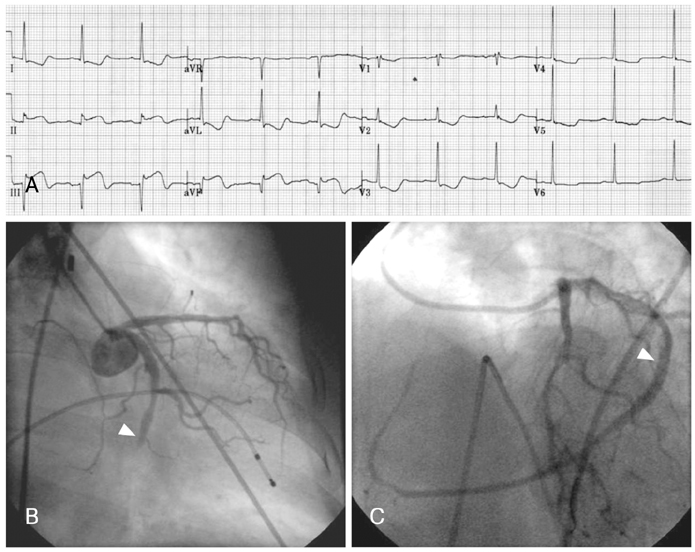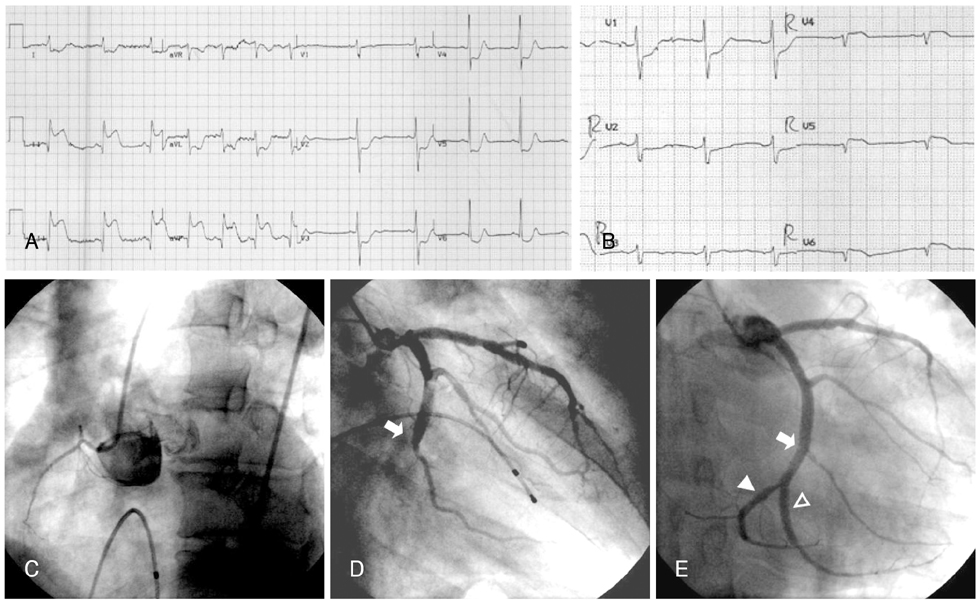Korean Circ J.
2007 Feb;37(2):84-86. 10.4070/kcj.2007.37.2.84.
Cases of Right Ventricular Myocardial Infarction in Patients with an Absent or Hypoplastic Right Coronary Artery
- Affiliations
-
- 1Department of Internal Medicine, Seoul National University College of Medicine, Seoul, Korea.
- KMID: 1859086
- DOI: http://doi.org/10.4070/kcj.2007.37.2.84
Abstract
- Two cases of myocardial infarction in the right ventricular (RV) wall, as well as the inferior wall, due to occlusion of the left circumflex coronary artery, with an absent or hypoplastic right coronary artery, are presented.
Figure
Reference
-
1. Lipton MJ, Barry WH, Obrez I, Silverman JF, Wexler L. Isolated single coronary artery: diagnosis, angiographic classification, and clinical significance. Radiology. 1979. 130:39–47.2. Yamanaka O, Hobbs RE. Coronary artery anomalies in 126,595 patients undergoing coronary arteriography. Cathet Cardiovasc Diagn. 1990. 21:28–40.3. Desmet W, Vanhaecke J, Vrolix M, et al. Isolated single coronary artery: a review of 50,000 consecutive coronary angiographies. Eur Heart J. 1992. 13:1637–1640.4. Blake HA, Manion WC, Mattingly TW, Baroldi G. Coronary artery anomalies. Circulation. 1964. 30:927–940.5. Fraisse A, Quilici J, Canavy I, Savin B, Aubert F, Bory M. Myocardial infarction in children with hypoplastic coronary arteries. Circulation. 2000. 101:1219–1222.6. Choi KL, Kwon JI, Jung WH, et al. Stenting of an anomalous coronary artery in acute myocardial infarction. Korean Circ J. 1998. 28:1378–1381.
- Full Text Links
- Actions
-
Cited
- CITED
-
- Close
- Share
- Similar articles
-
- Right Ventricular Myocardial Infarction due to Right Coronary Artery Total Occlusion Originating From the Distal Left Circumflex Artery
- 2 Case of Coronary Artery-to-Left Ventricular Fistulae
- A Case of a Single Coronary Artery Mimicking Anterior Wall Myocardial Infarction
- Precordial ST-Segment Elevation in Acute Right Ventricular Myocardial Infarction
- Two Cases of Multivessel Coronary Artery Ectasias Resulting in Acute Inferior Myocardial Infarction



